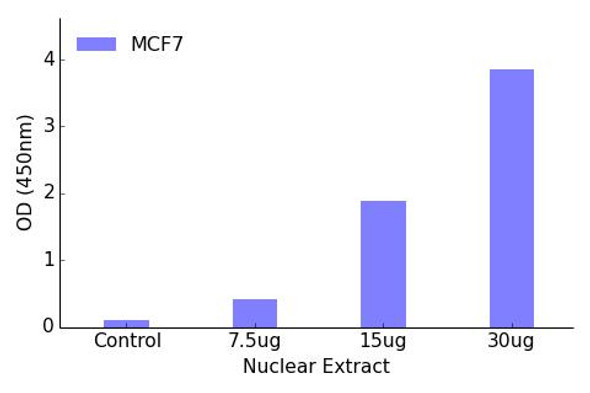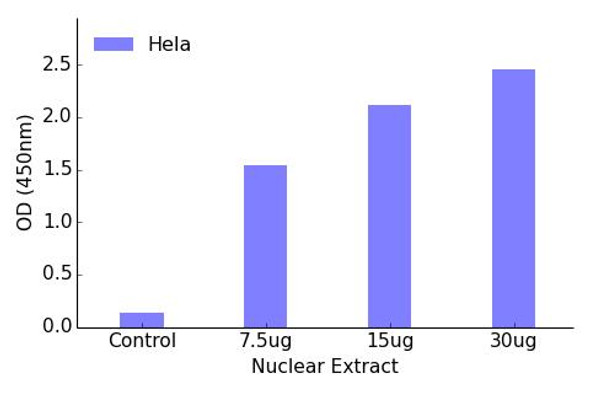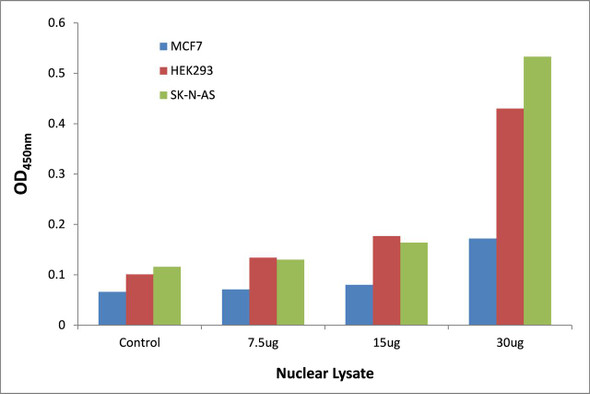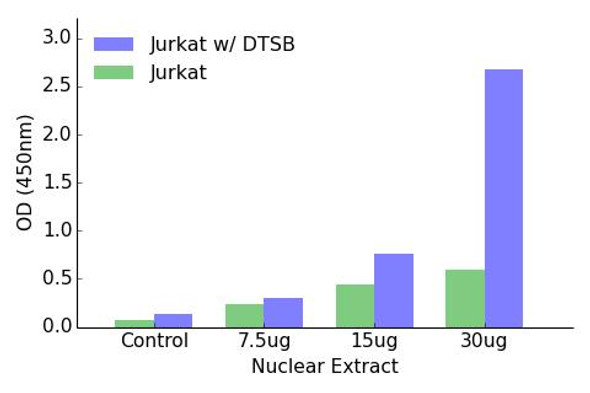SMRC2 Transcription Factor Activity Assay
- SKU:
- TFAB00190
- Product Type:
- ELISA Kit
- ELISA Type:
- Transcription Factor Assay
- Analytes:
- SMRC2
- Reactivity:
- Human
- Mouse
Description
SMRC2 Transcription Factor Activity Assay
The SMRC2 Transcription Factor Activity Assay offered by AssayGenie is a powerful tool for studying the transcriptional activity of the SMRC2 protein. This assay kit is specifically designed to accurately measure SMRC2 activity in various biological samples, including cell lysates and tissue homogenates.SMRC2 is a key transcription factor that regulates the expression of genes involved in various cellular processes, including cell growth, differentiation, and survival. Dysregulation of SMRC2 activity has been linked to various diseases, making it a valuable target for research and drug development.
With its high sensitivity and specificity, the SMRC2 Transcription Factor Activity Assay provides researchers with reliable and reproducible results, allowing for precise quantification of SMRC2 activity. This kit is ideal for a wide range of research applications, including drug screening, biomarker discovery, and mechanistic studies. Unlock the potential of SMRC2 research with the AssayGenie SMRC2 Transcription Factor Activity Assay.
| Product Name: | SMRC2 Transcription Factor Activity Assay |
| Product Code: | TFAB00190 |
| Target: | SMRC2 |
| Synonyms: | BRG1-associated factor 170, BAF170, SWI/SNF complex 170 kDa subunit, SWI/SNF-related matrix-associated actin-dependent regulator of chromatin subfamily C member 2 |
| Reactivity: | Human, Mouse |
| Sample Types: | Nuclear or cell lysates |
The Assay Genie SMRC2 transcription factor activity assay allows for the detection and qualitative analysis of endogenous levels of activated transcription factors in a variety of nuclear and cell lysates
Assay Genie ELISA kits are designed to significantly reduce experiment time and ensure sensitivity and flexibility for high-throughput screening.
| Assay Time: | 4.5 hours |
| Detection Method: | Colorimetric 450 nm |
| Size: | 12 x 8-Well Microstrips |
| Storage: | 4°C for 6 months |
| UniProt Protein Function: | Involved in transcriptional activation and repression of select genes by chromatin remodeling (alteration of DNA-nucleosome topology). Component of SWI/SNF chromatin remodeling complexes that carry out key enzymatic activities, changing chromatin structure by altering DNA-histone contacts within a nucleosome in an ATP-dependent manner (PubMed:11018012). Can stimulate the ATPase activity of the catalytic subunit of these complexes (PubMed:10078207). May be required for CoREST dependent repression of neuronal specific gene promoters in non-neuronal cells (PubMed:12192000). Belongs to the neural progenitors-specific chromatin remodeling complex (npBAF complex) and the neuron-specific chromatin remodeling complex (nBAF complex). During neural development a switch from a stem/progenitor to a postmitotic chromatin remodeling mechanism occurs as neurons exit the cell cycle and become committed to their adult state. The transition from proliferating neural stem/progenitor cells to postmitotic neurons requires a switch in subunit composition of the npBAF and nBAF complexes. As neural progenitors exit mitosis and differentiate into neurons, npBAF complexes which contain ACTL6A/BAF53A and PHF10/BAF45A, are exchanged for homologous alternative ACTL6B/BAF53B and DPF1/BAF45B or DPF3/BAF45C subunits in neuron-specific complexes (nBAF). The npBAF complex is essential for the self-renewal/proliferative capacity of the multipotent neural stem cells. The nBAF complex along with CREST plays a role regulating the activity of genes essential for dendrite growth. Critical regulator of myeloid differentiation, controlling granulocytopoiesis and the expression of genes involved in neutrophil granule formation. |
| NCBI Summary: | The protein encoded by this gene is a member of the SWI/SNF family of proteins, whose members display helicase and ATPase activities and which are thought to regulate transcription of certain genes by altering the chromatin structure around those genes. The encoded protein is part of the large ATP-dependent chromatin remodeling complex SNF/SWI and contains a predicted leucine zipper motif typical of many transcription factors. Alternatively spliced transcript variants encoding different isoforms have been found for this gene. [provided by RefSeq, Jul 2008] |
| UniProt Code: | Q8TAQ2 |
| NCBI GenInfo Identifier: | 57012959 |
| NCBI Gene ID: | 6601 |
| NCBI Accession: | Q8TAQ2.1 |
| UniProt Secondary Accession: | Q8TAQ2,Q59GV3, Q92923, Q96E12, Q96GY4, F8VTJ5, |
| UniProt Related Accession: | Q8TAQ2 |
| Molecular Weight: | 181 kDa |
| NCBI Full Name: | SWI/SNF complex subunit SMARCC2 |
| NCBI Synonym Full Names: | SWI/SNF related, matrix associated, actin dependent regulator of chromatin subfamily c member 2 |
| NCBI Official Symbol: | SMARCC2 |
| NCBI Official Synonym Symbols: | Rsc8; BAF170; CRACC2 |
| NCBI Protein Information: | SWI/SNF complex subunit SMARCC2 |
| UniProt Protein Name: | SWI/SNF complex subunit SMARCC2 |
| UniProt Synonym Protein Names: | BRG1-associated factor 170; BAF170; SWI/SNF complex 170 kDa subunit; SWI/SNF-related matrix-associated actin-dependent regulator of chromatin subfamily C member 2 |
| Protein Family: | SWI/SNF complex |
| UniProt Gene Name: | SMARCC2 |










